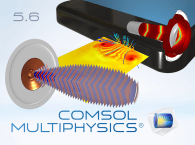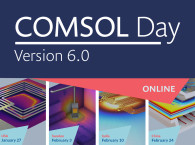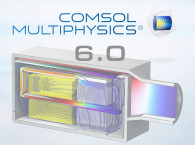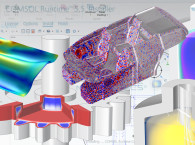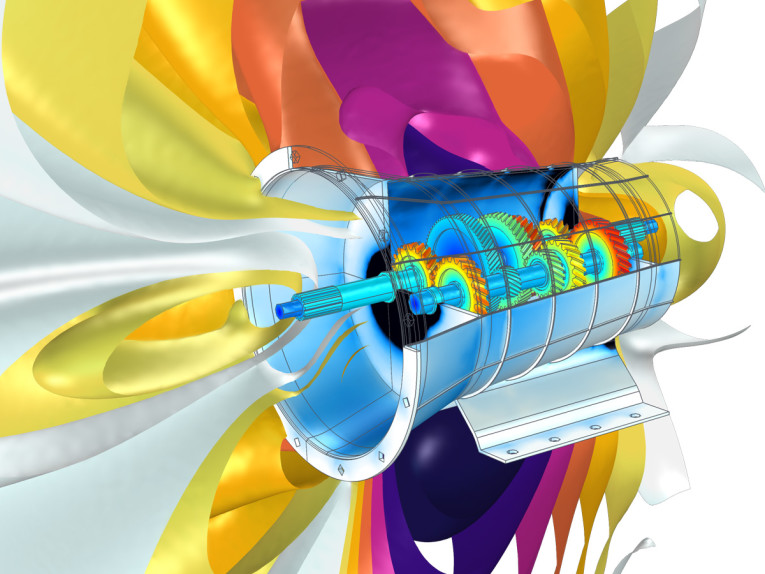
As COMSOL explains, version 5.3 is a major release that benefits simulation specialists with faster model and app development, shorter solution times, and new physics, increasing research and development throughput across all industries. There are hundreds of new and exciting features in the new COMSOL software for electromagnetics, structural, acoustics, fluid, heat, and chemical simulations. In many cases, users will experience a speedup of ten times or more in software responsiveness, such as in preprocessing tasks for handling models with several thousand boundaries and domains.
"Version 5.3 is a result of our continued focus on delivering highly capable mathematical modeling tools. Our users will find great value in new solvers, the new physics interfaces, and the many enhancements throughout COMSOL software, from model creation to deployment of apps", comments Svante Littmarck, President and CEO, COMSOL.
Apart from the always important performance improvements, highlights of new features and tools available in Version 5.3 include new physics for Thermoviscous Acoustics, Transient, and Poroelastic Waves, new particle tracing options and much more. With COMSOL version 5.3 the boundary element method (BEM) is now available for modeling electrostatics and corrosion effects. "This means that users can easily combine boundary element and finite element methods for greater flexibility in their multiphysics simulations", continues Littmarck. The Boundary Element method enables users to simulate models with infinite domains and voids, as well as to quickly set up simulations that combine wires, beams, surfaces, and solids in the same model. Typical uses for this functionality include the modeling of electrical cathodic protection, cables, or capacitive sensors.
Users handling large CFD models will benefit from the new algebraic multigrid (AMG) solver implemented in version 5.3. The AMG solver requires only a single mesh level and is now the default option for many fluid flow and transport phenomena interfaces. Users modeling turbulent flows can benefit from more robust computations with the automatic treatment of walls. This feature blends high-fidelity low-Reynolds formulation with wall functions.
The Model Builder now more rapidly handles geometry and mesh operations for models with large arrays and complicated solid operations in 3D. Users working with models and geometry requiring the use of several element types will benefit from the automatic generation of pyramidal elements to handle the transition between swept, hexahedral, prismatic, and tetrahedral meshes. A new option for automatic geometry defeaturing through virtual geometry operations is now available to users. "We continue to see improved performance for large models across the board. This is not only about solution time but also how the software handles large models in the user interface, including geometry and mesh", comments Bjorn Sjodin, VP of Product Management, COMSOL.
With the introduction of model methods in version 5.3, it is easy to automate repetitive operations directly in the Model Builder. "You can now simply record a set of operations, like a macro, and use the resulting method while setting up or solving a model. This is an important usability feature with many possible applications. For example, you can create a reusable model method that generates a complicated array of geometric objects to expand on the standard functionality of the Model Builder", continues Sjodin.

The Application Builder allows simulation specialists to create apps based on their multiphysics models. The app interface can be easily customized and accessed via a browser or a Windows client, which connects to a local installation of COMSOL Server. Updates to COMSOL Server include comprehensive log files for user activity as well as a centralized cluster administration setting in the COMSOL Server web interface for easy setup of running apps on clusters. In the Application Builder, app designers can now define customized actions when clicking on plots in graphics objects, enabling the easy creation of interactive apps.
The Application Libraries also feature more than 50 new and updated tutorial models, allowing users to quickly adopt new features, tools, and modeling techniques, spanning several areas, including many new useful examples for acoustics and transducers.
New on the Acoustics Module
COMSOL Multiphysics version 5.3 introduces new Acoustics Module functionality that greatly improves time-domain simulations of acoustics phenomena and facilitates solving large acoustics-based models. Further improvements include an array of new physics features and options as well as new postprocessing tools.
Improvements to time-domain simulations include Perfectly Matched Layers (PMLs) for pressure acoustics in the time domain; the Thermoviscous Acoustics, Transient interface for the time domain; transient solver settings being controlled at the physics level for more robust simulations; and speedup to the discontinuous Galerkin (dG) method.
Large models now benefit from ready-to-use suggested solver options for iterative solvers, and the option to use serendipity elements. New physics features and options include new and improved stabilization techniques for linearized Navier-Stokes analyses that are based on the Galerkin least squares (GLS) method; improved formulation for the Slip boundary condition in Wall features for linearized Navier-Stokes and thermoviscous acoustics applications (this works very efficiently when using iterative solvers); 2D axisymmetric formulation in the Convected Wave Equation interface; Biot-Allard model to include thermal and viscous losses in poroelastic wave simulations; new interior Perforated plate condition; improved ray acoustics formulation in 2D axisymmetric geometries; and beam width calculations for far-field plots.

With COMSOL Multiphysics version 5.3, the Pressure Acoustics, Transient physics interface now includes PML functionality in the time domain, for transient acoustic simulations based on the finite element method. PMLs are often used in situations where the default first-order, nonreflective boundary conditions would generate spurious and unwanted numerical reflections. PMLs enable users to truncate the computational domain with an external layer that mimics waves moving into an infinite domain. This was previously only available for the Pressure Acoustics, Frequency Domain and Convected Wave Equation, Time Explicit interfaces. PMLs can be added from the Definitions node and support both polynomial and rational scaling options for 3D, 2D asymmetric, 2D, and 1D models in Cartesian, Cylindrical, and Spherical geometries.
The Thermoviscous Acoustics node has been extended to include an interface for time-dependent linear thermoviscous acoustics simulations, which includes source terms represented by any time-varying signal, such as Gaussian pulses. The Thermoviscous Acoustics, Transient interface is suited for modeling time-dependent wave propagation in systems where thermal and viscous losses are important — typically in applications with small dimensions like mobile devices, miniature loudspeakers, microphones, or in the holes of a perforate.
The interface can be coupled through the Thermoviscous Acoustic-Structure Boundary multiphysics interface to structural mechanics applications and interfaces such as Solid Mechanics, Shells, and Membranes.
In applications where pressure and elastic waves propagate in porous materials filled with air, both thermal and viscous losses are important. A few example applications are insulation materials for room acoustics, lining materials in car cabins, foams used in headsets and speakers, and porous materials in mufflers. To better simulate these types of applications, a Biot-Allard model option has been added to the Poroelastic Waves interface. Including this model supplements the previously available Biot model option, which considers only viscous losses and is useful for acoustic poroelastic wave propagation in rocks and soils where the saturating fluid is a liquid.
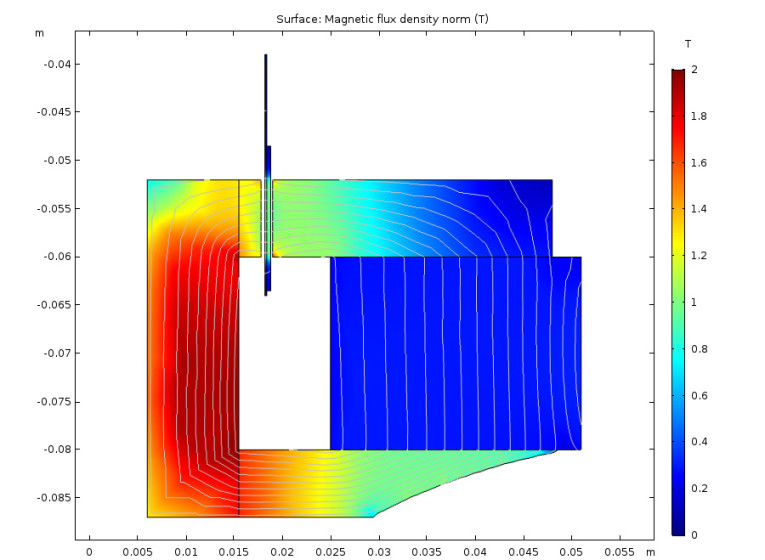
Up until now, the Pressure Acoustics, Frequency Domain interface together with an appropriate fluid model, such as the poroacoustic model, has been an adequate method for simulating many audio applications. However, these models do not capture all of the real-world effects and sometimes it is necessary to include elastic waves where, for example, the porous matrix needs to be coupled to vibrating structures. These can now be simulated with the new Biot-Allard model option in the Poroelastic Waves interface. Here, material inputs comply with typical conditions used and measured in audio and noise control applications.
With the addition of the Biot-Allard model option to the Poroelastic Waves interface, multiphysics interfaces that couple poroelastic domains, structures, and acoustics have been revamped and improved. These support coupling pressure acoustics to poroelastic waves and poroelastic waves to structures (and sometimes all three). You can add a new interface using the Add Physics button in the ribbon, which opens the Add Physics window.
The Convected Wave Equation, Time Explicit interface is now available for use in 2D axisymmetric simulations. This extends the capabilities to model the propagation of acoustic waves over long distances, as a measure of the number of wavelengths. The interface features an Include out-of-plane components option that can be used to include out-of-plane components of a background flow and their interaction with the acoustic signal. This can be used, for example, to model axially symmetric ultrasound transducers or tweeters.
Several of the physics interfaces in the Acoustics Module now provide suggestions for alternate iterative solvers in addition to the default direct solver that is set up when the physics interfaces have been chosen and the model is solved for the first time.
All the transient interfaces in the Acoustics Module now have a Transient Solver Settings section in the respective physics interface nodes. This sets up automatic controls of the default solver based on inputs provided in the new section, which leads to a better transient solver configuration and more robust simulations.
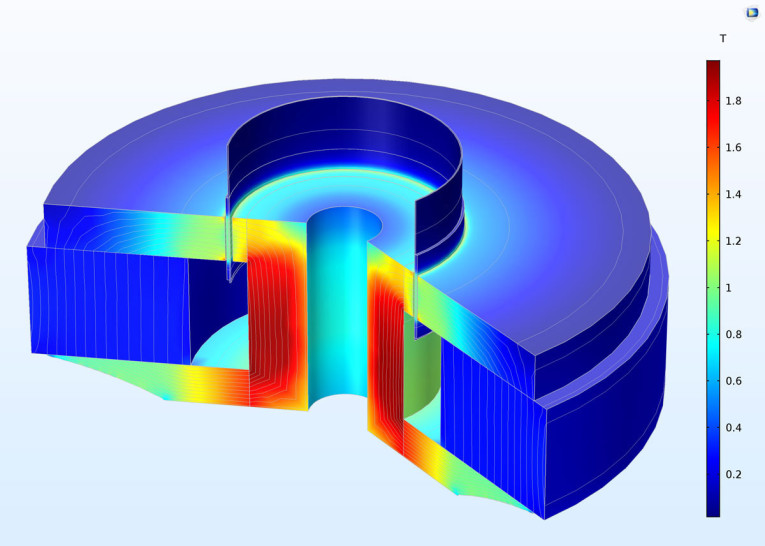
Mode analysis has been added in the Solid Mechanics interface for studying waves traveling in the out-of-plane direction for 2D structures, as well as circumferential modes in axially symmetric models. Mode analysis is particularly important in coupled acoustic-structure problems and works seamlessly in the coupled problems. This type of analysis can be used to analyze the propagating modes in applications such as waveguides, pipe systems, and mufflers.
The Interior Perforated Plate boundary condition, available in the Pressure Acoustics, Frequency Domain interface, has been updated and improved. The condition now includes full viscous and thermal loss models, hole-hole interaction using the Fok function, options to add nonlinear loss effects, and a formulation suited for both thin and thick plates. The boundary condition is typically used to model perforates in mufflers or in sound-proofing assemblies.
When computing ray intensity in 2D axisymmetric models, the wavefront associated with the propagating ray is now treated as a spherical or ellipsoidal wave, instead of a cylindrical wave, which was only ever an appropriate simplification in true 2D models. In other words, the principal radius of curvature associated with the azimuthal direction is computed for all rays. This improvement leads to more realistic calculations of the ray intensity in 2D axisymmetric models.
Additionally, dedicated features have been included to release rays from edges, points, or at specified coordinates along the axis of symmetry. When using one of these dedicated release features, a built-in option is available to release rays in an anisotropic hemisphere such that each ray approximately subtends the same solid angle in 3D.

The Wall feature now has several built-in models to calculate the reflection coefficient at specular reflections including a Fluid-fluid interface, Fluid-solid interface, and Layered fluid half space models. They complement the Absorber, specified impedance model, typically used in room acoustics to model absorbing panels. The attenuation in the propagation fluid and the attenuation in the domains, modeled by the boundary conditions, are also included to calculate a correct phase shift at the reflections. All boundary conditions can be extended with a Surface Roughness option using the Rayleigh roughness model.
The new Ray Termination feature can be used to annihilate rays without requiring them to stop at a boundary. Rays can be terminated if their intensity or power becomes smaller than a specified threshold or if they stray too far from the model geometry. This feature is useful to avoid using excessive computational resources.
A complete overview of the COMSOL Acoustics Module in V5.3, including many other improvements are provided here: www.comsol.com/acoustics-module
COMSOL will promote a webinar on "New Acoustics Module Features in COMSOL 5.3" on May 23 (2 p.m. CEST - 2 p.m. EDT). Go here to register.
COMSOL software products are supported on Windows, Linux, and macOST operating systems. The Application Builder is supported in the Windows operating system. To download the latest version of COMSOL Multiphysics software and COMSOL Server or update current installations, visit www.comsol.com/product-update.
www.comsol.com/release/5.3



